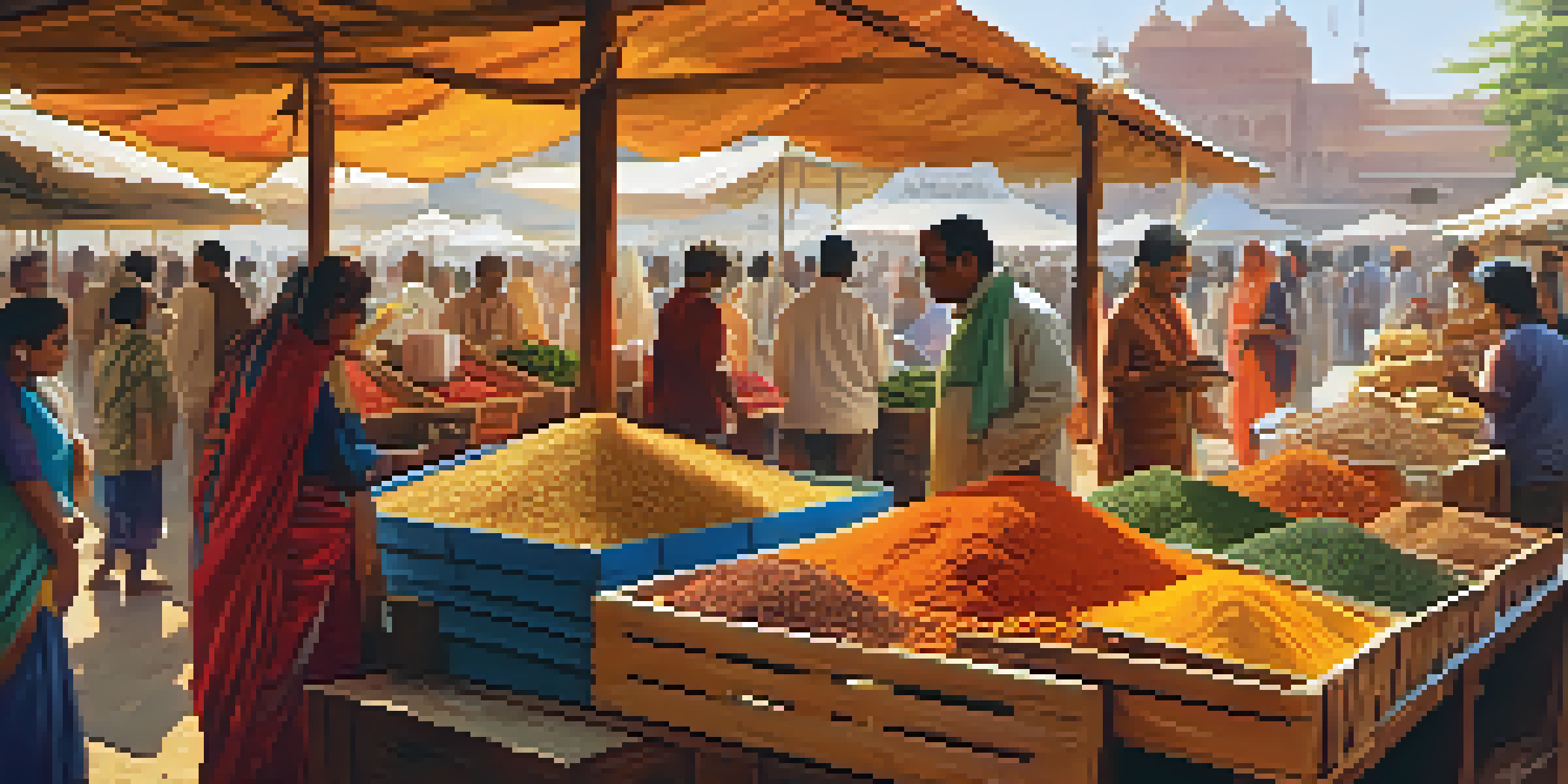Culinary Journeys: Indigenous Food Experiences in India

The Rich Diversity of Indigenous Cuisines in India
India is a land of immense cultural diversity, and its indigenous cuisines are a reflection of this richness. Each region boasts unique ingredients and cooking methods that have been passed down through generations. From the spicy curries of the south to the aromatic dishes of the north, these culinary traditions tell stories of the land, its people, and their history.
Food is the ingredient that binds us together.
Indigenous cuisines often utilize locally sourced ingredients, emphasizing seasonal and sustainable practices. For example, in the northeastern states, you'll find the use of bamboo shoots and fermented foods, which are integral to the local diet. This not only supports local farmers but also preserves ancient culinary knowledge that is at risk of fading away.
Exploring these diverse cuisines allows us to appreciate the intricate connections between food, culture, and identity. As we venture into the kitchens of indigenous communities, we uncover not just recipes, but a way of life that celebrates heritage and respect for nature.
The Significance of Traditional Cooking Techniques
Traditional cooking techniques are the heart and soul of indigenous food experiences. Many of these methods have deep-rooted significance, often linked to rituals, celebrations, and the community's way of life. For instance, the use of clay pots for cooking in many tribal communities not only enhances the flavor of the dishes but also connects them to their ancestors.

These techniques often include methods like slow cooking, smoking, and fermenting, which not only preserve the food but also enrich its taste. Consider the practice of smoking fish in the coastal regions of India, a technique that has been honed over centuries to ensure both flavor and longevity. It's a culinary art that embodies both necessity and creativity.
Diversity in Indigenous Cuisines
India's indigenous cuisines reflect cultural richness through unique regional ingredients and cooking methods.
Engaging with these traditional methods offers a unique insight into the cultural fabric of India. It’s a reminder that cooking is not just about nourishment; it's a bridge connecting generations and preserving stories that define a community.
Indigenous Ingredients: A Celebration of Nature
Indigenous food experiences in India are deeply intertwined with local ingredients that reflect the region's biodiversity. From wild herbs to native grains, these foods are often rich in nutritional value and flavor. For example, millets, once a staple across many states, are making a comeback due to their health benefits and resilience to climate change.
Cooking is one of the oldest arts and one of the most important. It is the essence of life itself.
For many indigenous communities, foraging for wild ingredients is a way of life. This practice not only supports their diet but also fosters a profound connection to their environment. Imagine wandering through a forest, gathering fresh greens and mushrooms, all while understanding the ecological balance of the ecosystem around you.
By embracing indigenous ingredients, we not only enhance our culinary experiences but also promote sustainable eating practices. It's a step toward acknowledging and respecting the intricate relationship between food and nature, which has been maintained by these communities for centuries.
Food as a Medium of Cultural Exchange
Food has an extraordinary ability to bring people together and foster cultural exchange. In many indigenous communities in India, sharing a meal is a sacred act that strengthens bonds and creates understanding. When we partake in these culinary experiences, we open ourselves to new perspectives and traditions.
Participating in indigenous food festivals or community feasts allows visitors to engage directly with the culture. For instance, festivals like the Hornbill Festival in Nagaland highlight local cuisine alongside traditional music and dance, creating a vibrant atmosphere of celebration and learning. It's an immersive experience that goes beyond just tasting food.
Sustainable Food Practices
Indigenous food systems emphasize sustainability through traditional farming methods that respect and nurture the environment.
Through these exchanges, we not only savor delicious dishes but also cultivate respect for the storytelling behind them. Each bite becomes a lesson in history, tradition, and the shared humanity that connects us all, transcending geographical boundaries.
Sustainable Practices in Indigenous Food Systems
Sustainability is at the core of indigenous food systems, where practices are designed to work harmoniously with nature. Many indigenous communities emphasize crop rotation, polyculture, and organic farming methods that maintain soil fertility and biodiversity. This sustainable approach contrasts sharply with industrial farming, highlighting a deep respect for the land.
For example, the traditional farming practices of the Toda tribe in the Nilgiri hills involve a symbiotic relationship with their environment, ensuring that their agricultural methods do not deplete resources. Their farming not only provides food but also maintains the ecological balance of the region, showcasing a model of sustainability that modern agriculture can learn from.
By embracing these practices, we can support local economies and promote ecological health. It's a vital reminder that the future of food lies not in exploiting the land but in nurturing it, just as indigenous communities have done for generations.
Indigenous Food Tourism: A Growing Trend
As travelers seek authentic experiences, indigenous food tourism is on the rise. Tourists are increasingly drawn to culinary journeys that offer insight into local traditions and practices. From cooking classes with indigenous chefs to farm-to-table experiences, these activities provide a deeper understanding of the culture.
This trend not only benefits the tourists but also empowers indigenous communities by providing a platform to share their culinary heritage. For instance, initiatives like the 'Eat Pray Love’ tour in Uttarakhand allow travelers to immerse themselves in local cuisine while supporting sustainable practices and local artisans.
Cultural Exchange Through Food
Sharing meals in indigenous communities fosters understanding and respect for diverse traditions and histories.
However, it is crucial that this tourism is approached responsibly, ensuring that indigenous communities retain control over their culinary narratives. By prioritizing authentic experiences, we can create a mutually beneficial relationship that honors the traditions while providing enriching experiences for visitors.
Preserving Indigenous Culinary Heritage for Future Generations
Preserving indigenous culinary heritage is vital for maintaining cultural identity and diversity. As globalization influences food trends, many traditional recipes and practices are at risk of being forgotten. Initiatives aimed at documenting and sharing these culinary traditions are essential for ensuring their survival.
Organizations and community-led projects are increasingly working to archive indigenous recipes and cooking techniques. Through workshops, cookbooks, and online platforms, these efforts help raise awareness about the importance of indigenous food systems and encourage younger generations to embrace their heritage.

By valuing and preserving these culinary arts, we not only honor the past but also enrich our future. Each recipe preserved is a story saved, a connection to our roots maintained, and a celebration of the rich tapestry of human experience that food embodies.